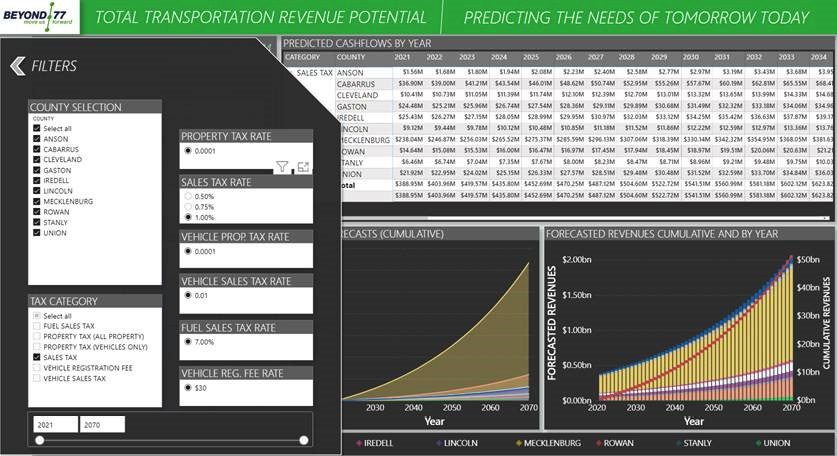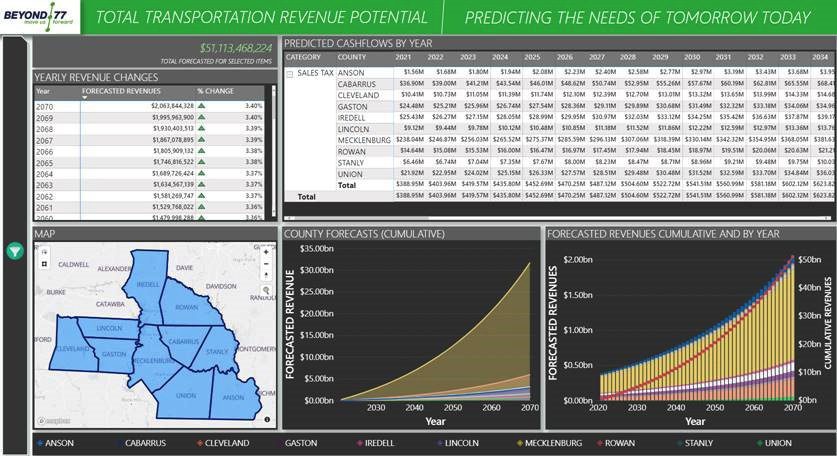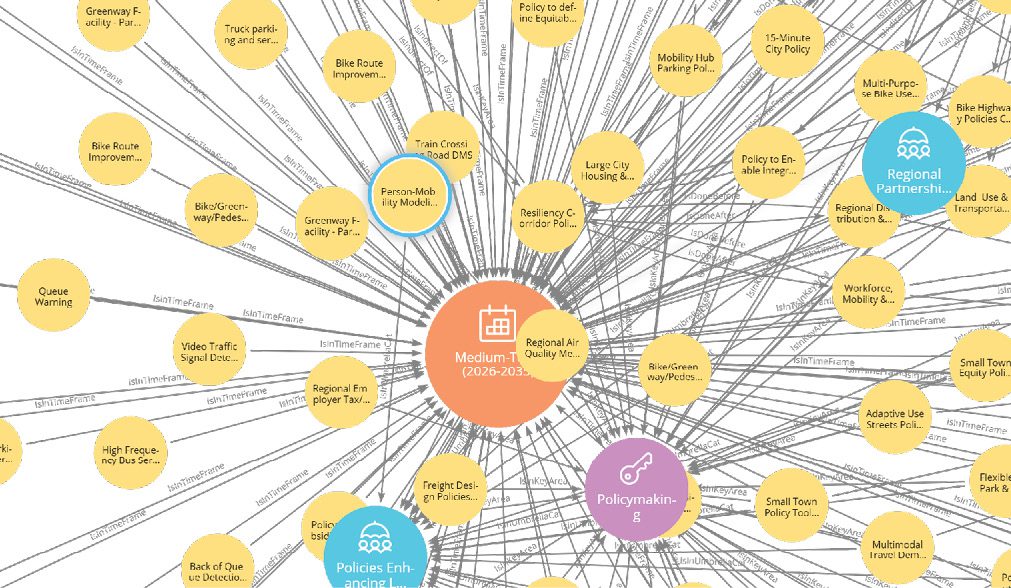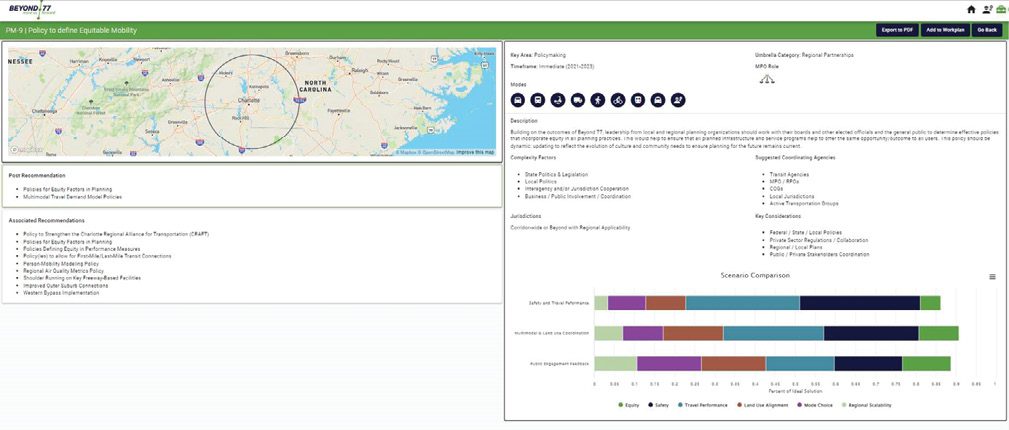The Beyond 77 Corridor Study: Atkins Helps Develop Project Planning with an Eye to Policy

The Beyond 77 Corridor Study, facilitated by the Charlotte Regional Transportation Planning Organization (CRTPO), started with a goal to find ways to reduce congestion and increase multimodal options along and around the 68-mile-long, 400-plus-square-mile study area. That early vision evolved considerably when the agency, at the recommendation of its study consultant, looked beyond just adding more lane miles or vehicular capacity, but through a more-comprehensive lens to consider policy and programmatic needs that could enhance mobility in the future across the network.
It’s a broader perspective that resulted in adoption of the region’s first-ever technology-enabled corridor evaluation toolkit that comprises 286 strategies and solutions culled from extensive non-traditional stakeholder coordination and public engagements.
This toolkit—called the Strategic Users Implementation Tool (SUIT) and facilitated by a customized online application—allows planners, decision-makers and members of the public to get involved in the overall planning and implementation efforts. It also has become a framework that will guide decision making of major transportation projects, programs and concepts along this corridor for the next 30-plus years.

The FAST Application View shows the user’s options to select involved counties, desired additional fees and/or taxes, and associated rates to model into the future.

This FAST Application View shows a map of counties selected as well as a series of tables and charts to visualize annual and total revenues forecasted by county through selected horizon year.
Common Intersections
The population of the Charlotte metropolitan area and surrounding regions is expected to nearly double by 2050, a growth that will place a heavy burden on the region’s transportation networks, especially I-77. Beyond 77 was launched in January 2020, with Atkins as the lead consultant, to develop effective strategies and solutions for the I-77 corridor moving forward.
The six key elements of the study included the following:
1. Congestion management
2. Connectivity within the parallel networks
3. Funding
4. Technology
5. Multimodal systems
6. Land-use coordination
Early on, Atkins developed the Lifecycle of Transportation Planning to help guide critical conversations and begin formulating ideas for potential mobility solutions across the key areas of concern with community leaders and stakeholders as well as state and local entities.
Also critical to the success of the Beyond 77 Corridor Study was public participation. For this effort, the Atkins team relied on a carefully curated and nontraditional marketing and public-engagement plan. The plan targeted specific audiences, ultimately encouraging active participation throughout the study, gathering feedback from local residents through a series of email blasts, public workshops and community forums.
“We did not just host public meetings or webinars and hope people joined,” explains Adam Howell, AICP senior director at Atkins and consultant team project manager. “We went to the people. The survey links were blasted regionally, using IP targeting and geofencing for social media applications, based on demographics, profession, etc.”
And the ROI of this method proved impressive. CRTPO and Atkins received more than 25,000 survey responses during the study—a significant improvement compared to historical public-engagement surveys. “The public-engagement piece was one of the primary drivers of this project’s success,” adds Howell. “The responses became an essential piece of the strategies and solutions that would emerge. We were able to bring people from all backgrounds together to talk about very complex issues and find solutions.”
To further enhance the review of the public’s feedback, Atkins enabled dynamic analysis platforms through use of PowerBI. These digital dashboards allow for macro or micro analysis based on jurisdiction, demographics, ZIP Code or even the census block of a particular group of constituents tied to the public-engagement data. It’s an innovation that was paramount in handling the sheer volume of engagement data received as well as facilitating the final recommendations.
Project: Beyond 77 Corridor Study
Location: Charlotte, N.C.
Country/Region: United States of America
Client: Charlotte Regional Transportation Planning Organization
Completion Date: June 2022
Project Manager/SME: Adam Howell, AICP Senior Project Director, Strategy Manager
Global Practice: Consultancy & Advisory
Working closely with the Atkins team, CRTPO ultimately adopted the 286 strategies and solutions focused on social, economic and resilient elements as part of the Beyond 77 Corridor Study. Of note, several divisions of the North Carolina Department of Transportation (NCDOT), such as Integrated Mobility and Intelligent Transportation Systems, were involved in the approval of all strategies and solutions that were ultimately selected.
Putting that many strategies and solutions into action required even more help from technology.

This image is an excerpt from the full view of the graph database used to power the SUIT application. Arrows indicate layers of relationships and interdependencies across all strategies and solutions identified through Beyond 77.
Digital Dimensions
Building on the innovations from the engagement data dashboards, Atkins created a custom digital framework delivered on the client’s request of a flexible planning toolkit. The SUIT toolkit is built for planners, decision makers and the general public to interact with proposed recommendations while deriving critical high-level information that ranged from communities served to schedule. SUIT is a custom user interface designed to incorporate graphical databases. These specialized databases are coded to showcase relationships across all strategies and solutions that, in turn, help educate users on how each strategy or solution may potentially be dependent on one another.
Within SUIT, a user can see any set of strategies and solutions with ties to a city, town or county as well as a suggested sequence of implementation through time. They can view modes that are expected to benefit from each of the strategies and solutions as well as view tailored details with comprehensive perspectives for all aspects of implementation.

A custom user interface was designed to allow anyone to easily navigate the graph database platform. Set up like a “shopping experience,” SUIT allows planners, leaders and citizens to plan together and understand choices and tradeoffs with implementation decisions. This image shows details of a specific strategy or solution as well as critical details to help foster further implementation.
Planners can even create custom bundles or personalized Work Plans to help foster further dialog and drive implementation of a chosen strategy or solution over a certain timeframe. By creating custom Work Plans, any individual can explore priorities unique to the jurisdiction or agency they represent as well as plan for local or regional coordination of implementation needs. This innovative tool helps inform the planner about the level of staff resources that may be necessary, any associated direct costs and agencies that should be considered for coordination.
“The planning tool allows a local planner, for instance, to see how a larger CRTPO effort might influence land-use policies in their area down the road—and plan accordingly,” explains Howell. “It essentially breaks down the traditional silos that exist in the regional planning process. Or it could help planners collectively work together to benefit regional infrastructure investments—a coordinated effort that would help influence state funding.”
Another strategy is the emerging technology recommendations. In this case, one of the recommendations is Connected/Autonomous Vehicles (C/AVs) & Traffic Data Sharing Apps, a long-term solution under the Emerging Technologies key area. The goal of this strategy is to develop software solutions that enable data sharing, data integration and data analytics that benefit the user and operating entity while improving reliability and journey planning.
This effort ties nicely with the PM-13, C/AV & Emerging Mobility Technology Policy Development, an effort that stems from the formalization of the C/AVs Working Group and larger ensuing dialogs. It emphasizes the need for state, regional and local agencies to consider policy needs applicable for effective incorporation of C/AVs and other mobility-related technologies into existing planning and programmatic functions.
FAST Opportunity
The Beyond 77 team knew that funding strategies would be a necessary and integral piece of the success of the proposed programs and projects. Building on the flexibility of SUIT and the public-engagement data dashboards, the team finalized a series of short-term funding strategies that were enabled by state statutes.
The strategies were documented in the Funding Alternative Strategies Tool (FAST), which can be used to explore six short-term funding alternative strategies across multiple counties within the Charlotte metropolitan area.
“The purpose of the FAST tool is to help leaders and staff start a conversation about what it means to look at funding through a regional lens,” explains Howell.
FAST allows users to see how an increase (or decrease) in funding would impact programs through time. A user can input information to see what monies could be raised based on different forms of funding strategies.
A second component of FAST is a breakdown of where all anticipated funds could be used to facilitate different modes of transportation solutions, such as roadway miles or buses or miles of greenway. Users then can quickly determine funding allocations for each of those modes.
The funding strategies were developed to inform a series of choices and tradeoffs, analogous to the development and intent of the strategies and solutions. As the Beyond 77 final report (at bit.ly/3Nh9cPo) notes: “The funding strategies serve as a critical part of the greater dialog seeking coordination across jurisdictional boundaries to provide solutions to regional needs. The implementation of the strategies and solutions, paired with one or more of the identified funding strategies (and even other regionally coordinate initiatives), will support effective large-scale investment in transportation infrastructure benefiting generations to come.”

A Beyond 77 graphic was created to visualize the choices and tradeoffs of public investment at certain levels. It supported public engagement as a critical visual aid and continues to support the conversation in the Charlotte metropolitan area as agencies and leaders determine next steps forward to seek additional funding for public infrastructure investment.
Collaborative and Connected
The strategies and solutions developed as part of the Beyond 77 Corridor Study are designed to meet multiple objectives that range from safe and equitable mobility options to enhancing freight connectivity. Also, CRTPO sought to ensure that any transportation policies and programs were sensitive to environmental justice and equity.
For instance, one of the strategies includes the implementation of Greenways & Mobility Hubs. This solution recommends the implementation of greenway and multi-use path infrastructure along key corridors to connect to transit stations and mobility hubs, allowing more multimodal options to connect across the region. To move the region into a more-sustainable and equitable future with a range of transportation options, new and safe connections for bicycles and pedestrians must be made to transit investments and areas of high density.
These connections will allow improved utilization of transit investments, benefitting regional transit operability as well as individual users’ ability to access them in a safe and useful way.
Another strategy example includes Policies for Equity Factors in Planning, which recommends the development of new, optional policy language elements for jurisdictions and organizations to adopt into local planning and project work. This language would seek to effectively define what equitable mobility means across the Charlotte metropolitan area. Equity has become a critical element to consider with all planning functions, beyond standard requirements defined by federal or state agencies. The Beyond 77 team believes the jurisdictions in the Charlotte metropolitan area have an opportunity to pair equity needs between land use and transportation planning.
Constant collaboration between Beyond 77 and the parallel regional transit plan, CONNECT Beyond, managed by the Centralina Regional Council and the Charlotte Area Transit System, helped provide regional transit recommendations that traversed the Beyond 77 study area across multiple transit modes as well as strategies and solutions needed to align. Both study teams shared information frequently to ensure ideas supplemented each other for optimal outcomes.
“One of the greatest benefits of the Beyond 77 Corridor Study has been the ability to provide tools that enable users to break out and tailor pieces of the proposed solutions and also provide an innovative, comprehensive and flexible suite of implementation elements, from new policies, programs and projects,” summarizes Howell. “The application allows CRTPO, its member jurisdictions and stakeholders to collaboratively develop implementation efforts for these strategies and solutions and understand how they are all related and impact the success of one another. Beyond 77 is one of the nation’s most-comprehensive studies of its kind. The outcomes have set us up as an organization to enhance our planning and coordination efforts that will improve mobility along such a critical corridor.”

Meet the Beyond 77 Project Manager
In May 2023, Informed Infrastructure Editorial Director Todd Danielson interviewed Adam Howell, AICP senior director at Atkins and consultant team Project Manager, to learn more about this fascinating project and its related innovations.
The full video interview can be viewed at bit.ly/3CRBc65
About Dean Goodison
Dean Goodison is Atkins East-South Sector Manager in the Community & Intermodal Infrastructure (C&II) Business Unit; email: [email protected].


